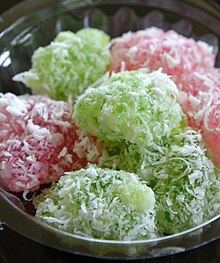Khanom tom (Thai: ขนมต้ม, pronounced [kʰā.nǒm tôm]) and khanom kho (ขนมโค, [kʰā.nǒm kʰōː]) are closely related traditional Thai desserts. Khanom tom is used in Central Thailand, while khanom kho comes from Southern Thailand. Khanom kho are boiled glutinous rice dumplings stuffed with a palmyra palm sugar cube and rolled in shredded coconut, while khanom tom have caramelized shredded coconut fillings.[1] They are approximately the size of large gumballs and come in different colors, typically red, green, blue, purple, or off-white (sans food coloring). They are sometimes served in a bath of warm coconut milk. Khanom kho are sold in markets, food stalls, and restaurants and made in homes throughout Southern Thailand. They are served at ceremonies, festivals, parties, and weddings.[2][3][4]
 | |
| Alternative names | Khanom kho |
|---|---|
| Type | Dessert |
| Place of origin | Thailand |
| Associated cuisine | Thai |
| Main ingredients | Glutinous rice flour; jaggery; shredded coconut |
| Similar dishes | Modak, kuih kochi, tang guozi, nom plae ai, yomari, kangidan |
Taste
editLonely Planet describes the taste of khanom kho as follows:
The outer coating of grated coconut is rich and oily, and so fresh it has a natural crispness to it. The wrapping, made of just water and sticky rice flour, is soft and slightly sticky. The sweetness of khanom kho comes only from the inside, where a piece of palmyra palm sugar is planted, and provides a nutty caramel flavour and a little crunch. A hint of saltiness added to the outer shreds of coconut, enhances the flavour of the sweet core.[2]
Ingredients
editKhanom kho are made from glutinous rice flour, palmyra palm sugar, grated coconut, salt, butterfly pea flowers or purple food coloring, and pandan leaves for coloring.[4][5]
Similar desserts
editKhanom tom and khanom kho are two of many steamed or fried sweet flour dumplings found across Asia. These include the modak from India, kuih kochi from Malaysia, tang guozi from China, nom plae ai from Vietnam, yomari from Nepal, and kangidan from Japan.[6][better source needed]
See also
editReferences
edit- ^ กนกพร หมีทอง (3 December 2017). "ขนมโค ต้นตำรับปักษ์ใต้หาทานยากกว่า 100 ปี ทำง่าย กินอร่อย". Sentangsedtee Online (in Thai). Matichon. Retrieved 19 September 2023.
- ^ a b Lonely Planet Food (2015). From the Source - Thailand: Thailand's Most Authentic Recipes From the People That Know Them Best. Lonely Planet Global Limited. p. 438.
- ^ "The sweet life". Bangkok Post. April 19, 2016.
- ^ a b "An Illustrated Guide to Thai Desserts (and Where to Find Them)". Big Chilli. April 30, 2022.
- ^ Lonely Planet Food (2015). From the Source - Thailand: Thailand's Most Authentic Recipes From the People That Know Them Best. Lonely Planet Global Limited. p. 439.
- ^ "Around Asia in six sweet dumplings". Mint Lounge. 2022-09-14.